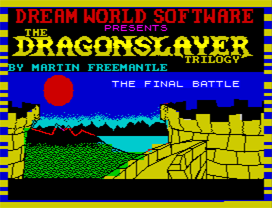Dream World Adventures

Dream World Adventures, launched in 1992 and run by Martin Freemantle, was one of the last big homegrown ZX Spectrum text adventure labels. Dream World's unique, interesting and devious games were always meticulously presented. In November 2021, Martin was kind enough to chat to me about those days and talk a little about his adventuring plans for the future...
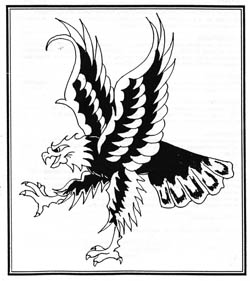 When did you acquire your first computer?
When did you acquire your first computer?
"Roughly about 1989; a 48k spectrum with a tape deck and a bundle of games. It was supposed to be for the kids... within a few weeks I had to buy another one so the kids could have their one back. I got myself a 128+2A, with built-in tape deck and I was hooked."
How did you get into adventure gaming?
"Well that bundle of games I mentioned before had things like Horace Goes Skiing and the like, which was of no interest to me. But one game in particular caught my eye: The Fourth Protocol. I'd read the book, seen the film and any movie with Michael Caine is a must watch. I`m a film buff and I`ve maybe seen 90% of Michael Caine films, that's about 108 films. Anyway I loved the game and played till I finished it.
One day my wife comes home from shopping and says here I`ve got you this, a copy of Crash magazine. It had a tape on the cover, loads of free stuff, and damn loads of rubbish too. But I read it from cover to cover and came across the adventure section. Next day I`m out to the newsagents and buying up every computer mag; Your Sinclair and Sinclair User too.
So I come across this adventure on a cover tape called Temple of Terror, I love the name already. I load up and start typing, well finger pecking I believe it's called. Ten minutes in and I'm continuously being killed by pirates."
(Temple of Terror, by Adventure Soft for US Gold, was an adaptation of the Fighting Fantasy book of the same name. Bizarrely, it appeared on the Sinclair User covertape not once but twice in 1991!)
"Over a period of a few weeks I managed to get about halfway through the game. I did read a few years later that the game was bug ridden and could not be finished.
I started to buy as many adventures as I could find, discovered Adventure Probe and that's how it continued till October 1991. That's when I went to the convention in Birmingham and put faces to names like so many others did as well."
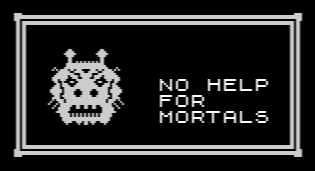 How did you end up writing your first game?
How did you end up writing your first game?
"I would say three things contributed to me turning to writing my own adventures. One that quite a few authors have said is I can do this or even better. Two, I was looking for a new challenge, and finally the third was meeting a certain person. I was at the convention with a friend of mine Barbara Gibb. I knew this would cause a stir or I hoped it would, and confusion too. And it did…"
Indeed! The better known Barbara Gibb was a longstanding member of the community, as a playtester and reviewer, and she'd also just taken over the reins as editor of the Adventure Probe fanzine, so having someone else wandering around the convention with the same name was sure to cause confusion!
"...I love playing jokes, spinning tall tales and having a good old laugh. Anyway, I'm standing there when all of a sudden this tall gangly character grabs my hand and proceeds to pump my arm up and down twenty to the dozen and just gabbles away. None of which I'm listening to as I'm too busy watching his Adam's apple bob up and down and I'm thinking I`ve just met Ichabod Crane from the Disney version of Sleepy Hollow. Then I realize what he's saying, "Mr Freemantle, my best customer over the last few weeks, you have bought my entire catalog of games". It's none other than Larry Horsfield, so we have a good old chat and Larry tells me all about PAW. He's so enamored by it and writing adventures, it's a passion that he does for the love of. He suggested that I should try writing an adventure, so I did..."
Your first published game, Dragon Slayer, debuted in 1992. Although the setting was fairly-standard fantasy, of the "kill the dragon… find the magical amulet" variety, the polish and presentation made it stand out, particularly as a first game from a new author. How long did it take to write?
"Dragon Slayer from start to being ready to sell took about eleven and a half months. Seems like a long time but I learned PAW as I programmed the game. I kind of jumped in the deep end. I don`t know how Tim Kemp got hold of it and did a review but he did and he liked it. I did a lot of new things in Dragon Slayer which I improved on in each new adventure."
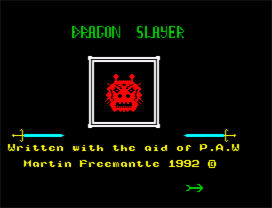 |
 |
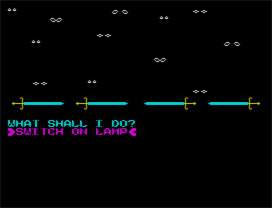 |
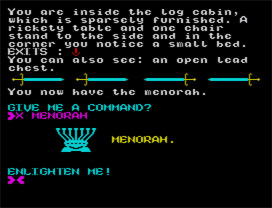 |
 |
 |
| (Above: Screenshots from Martin's first game: Dragon Slayer) | ||
You implemented a very neat screen display; using colours, different fonts, and dividers to make everything easy to read. Location exits were shown graphically using compass indicators. There was good use of the PAWs timing commands to gradually display text so a player wasn't swamped with everything at once. What led you to settle on this particular presentation style? Was it in response to games you'd played yourself?
"What I was hoping to achieve was something new and maybe better in some way. Not knocking any other author at all, as it`s a style like music or books. Example I like Lee Childs, my Mrs likes Stephen King. I don`t but that doesn't make one better than the other, just different styles and different tastes. It's like you said a bit of extra polish. I suppose I did them the way I wanted to see them as if it was me playing the adventure. That is what makes them better to me."
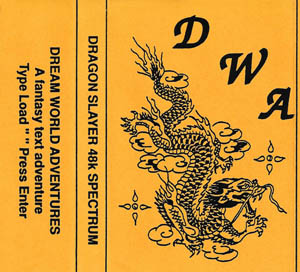 Dragon Slayer was initially released in two editions: a single-load 128K version and a two-part 48K game. What was the thinking behind that? Was it worth the extra effort?
Dragon Slayer was initially released in two editions: a single-load 128K version and a two-part 48K game. What was the thinking behind that? Was it worth the extra effort?
"When I did Dragon Slayer I was not thinking about selling the game at that time, like I said I jumped straight in and set about writing it in 128k mode. About three-quarters done I asked Sharon Harwood if she would take a look at it. She did and corrected my terrible spelling and grammar. She said I should finish it and sell it, which I did. Then the requests came in, where`s the 48k version? So I did one. After that all games were then in 48k only."
The game was certainly impressive enough to be published by one of the well-established homegrown labels at the time. What made you decide to publish the game yourself? It couldn't have been a burning desire to spend all your time duplicating tapes, photocopying inlays and stuffing jiffy bags?!
"I was always going to do it all, that's the way I am. Like doing the artwork on the cassette inlays. I spent four years as a tattooist. John Wilson [of Zenobi Software] did contact me and offered to sell my stuff. Someone else did too, I can`t remember who though."
 |
 |
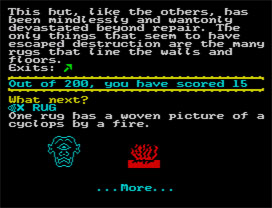 |
 |
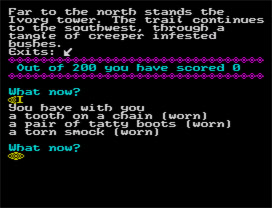 |
 |
Dragon Slayer was eventually expanded into a trilogy of games with Death or Glory and The Final Battle. This time the focus was 48K only. Death or Glory had two parts and The Final Battle just one. Was a trilogy always the intention?
"By the time I had finished Dragon Slayer there was so much more I wanted to do that there was always going to be a follow up. That then grew into two parts, so I then had to do a third part to finish it off. Hence the trilogy."
 The two sequels were also incredibly well-presented, particularly Death or Glory which featured another fun climbing animation and the very amusing section where you splat the cyclops in the eye with mud. These weren't the sort of things that many authors were doing at the time!
The two sequels were also incredibly well-presented, particularly Death or Glory which featured another fun climbing animation and the very amusing section where you splat the cyclops in the eye with mud. These weren't the sort of things that many authors were doing at the time!
"I was very pleased with Death or Glory or "Dog", my filename when saving the database. I think I had learned alot from the first game and wanted to make PAW do things that other authors had not, apart from people like Jack Lockaby who lived just down the road from me, well a few towns away. Jon Lemmon did great stuff too but not from within PAW, but still impressive. The guy who did The Mapper; made great use of the flags and process tables in PAW. I think The Mapper has about 1500 locations."
Yeah, The Mapper is a very clever bit of PAWs programming by Karl Bunyan. Jack Lockerby managed to include 1,500 locations in his The Bounty Hunter game too.
"The animation bits in DS were a new idea but very basic, a bit like drawing a stick man in the corner of a book and then flicking the pages. In DoG I improved on this idea and made them more natural looking although still quite simple. As one reviewer said, 'I look forward to the next one and want to continue'."
Because you came to adventure publishing quite late, you sadly mostly missed out on the days where the mainstream computer magazines covered text adventures. Both Dragon Slayer and Death or Glory did manage to scrape into the last columns by Tim Kemp in Your Sinclair, though.
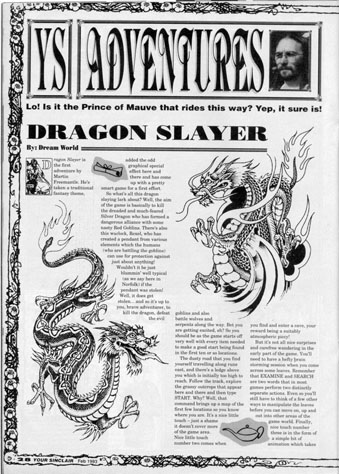 |
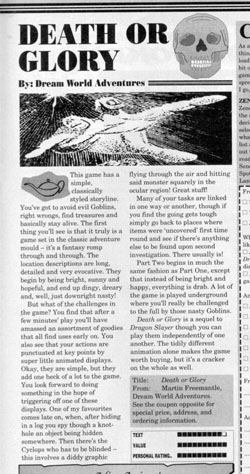 |
| Reviews of Dragon Slayer and Death or Glory in Tim Kemp's Your Sinclair adventure column | |
Dragon Slayer obtained a very respectable 7/10 in the February 1993 issue, but it was Death or Glory that really impressed Tim… receiving a personal rating of 10/10! That must've felt good, particularly as there was a special offer coupon to order the game in that last column?
"It was nice to see Tim Kemp's review 10 out of 10. It doesn't get any better than that. And I was very pleased with 7/10 for a first game as well. I must have been doing something right.
It was unfortunate that by the time I was in full flow the three big mags were gone or were soon to. Plus other computers were on the rise. Even myself I had acquired an Amiga 600 and very soon after that a A1200 with a hard drive and extra memory. A year later a PC as well. So by 1997 I had 6 Spectrums, 2 Amigas, and 2 PCs."
 After the death of the mainstream magazines the text adventure scene survived in the pages of fanzines and with the support from the healthy community that grew up around them. Magazines like Adventure Probe , Red Herring, From Beyond, the Adventure & Strategy Club dossiers, and tip-centric zines like Bare Bones. How did you first come across Adventure Probe?
After the death of the mainstream magazines the text adventure scene survived in the pages of fanzines and with the support from the healthy community that grew up around them. Magazines like Adventure Probe , Red Herring, From Beyond, the Adventure & Strategy Club dossiers, and tip-centric zines like Bare Bones. How did you first come across Adventure Probe?
"Adventure Probe I probably saw an advert in one of the mainstream magazines also Bare Bones too. Its editor. Les Mitchell did some playtesting on some of my games."
Your next games left the world of the Dragon Slayer behind. The Curse of the Serpent's Eye starred Jenny Peril, a time-jumping cadet, trying to get through her Federation of Peace test. A female protagonist was still surprisingly unusual at that time, despite the large number of female text adventure players. Was it a deliberate choice?
"The Jenny of Jenny Peril saga is in fact Jenny Perry, part of the London gang and a lovely dear friend. To be honest It was a piss take but in a very nice way. I`ve always thought of males and females as just people, I`ll leave it at that.
Curse of the Serpent's Eye was to be a Megapoints game only but I got carried away and it ended up a full game. That's why it's a mish mash, not a real thought out planned adventure and the reason for [the sequel] (and please take note) Golden Figures of Death. NO F*CKING "THE" at the beginning. That's the one thing that`s miffed me off for twenty plus years."
That sequel, The Golden Figures of Death… sorry, Golden Figures of Death... featured a similar presentation routine to those that Jack Lockerby used in his River adventures; where any actions, such as dropping or picking up items, would instantly and very neatly update the location text at the top of the screen.
"...yes [Golden Figures of Death was] the follow up or the much better game; my favourite and the best in my opinion. I wanted to do the same as Jack Lockerby for two reasons. One, I like Jack's games and I liked the instant screen update and two, I needed to be able to do it myself. Also there's loads of screen manipulation as well, kind of my magnum opus for me. I was on form, the whole game was written in 30 days and the only thing the playtesters found wrong was spelling and grammar, I was notorious for it back in the day. One lady playtested for me and refused to do any more until I had learnt to spell and write better. Very funny I thought."
 |
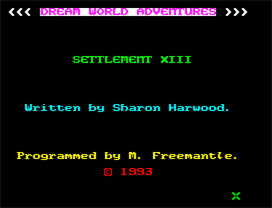 |
 |
 |
 |
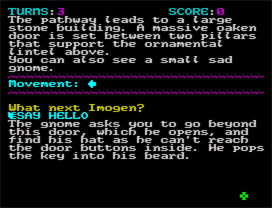 |
Settlement XIII was a bit of a departure, in that it was a two-part game designed, not by yourself, but by your main playtester Sharon Harwood. How did that game come about?
"Sharon`s first game Settlement XIII: She did the whole thing on paper and asked me to program it then release it. So we did part one. Part two took forever to arrive and the reason was she was doing her second game herself. All her games are brilliant apart from the "Spectre of Larry Nagmedows". Tee-hee.
Yes, she had started to do her own programming. I must say a few game writers were put out that she chose me. I did ask her why and she said she knew she could trust me and I wouldn't be so damn high and mighty, plus she loved me too. Another tee-hee."
It's a very atmospheric game, different to most Spectrum text adventures out there. The tone and subject matter is very serious. Not everything is revealed initially. You find yourself exploring and trying to survive in quite a bleak and brutal world, one suffering the aftermath of a catastrophic event. It's a game that really stands out.
"Like I said, it's brilliant."
 |
 |
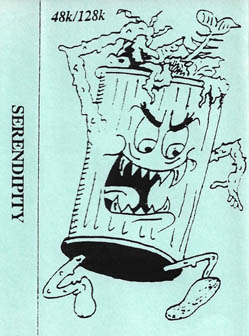 |
Sharon went on to write The Chameleon Key and A Promotional Prospect for Dream World. She wasn't the only author that you published games by. So Little Time was a port of a Commodore 64 Quilled game by the prolific Damien Steele. What led you to work on that and how did you go about porting a game from the Quill on the C64 to the PAW on the Spectrum?
"So Little time by Damien Steele, Now there's a lovely little fellow, a lot of folk thought of him as a young cocky wet behind the ears pip squeak. But I liked him.
Anyway, he was bragging that he could write a game in one day and of course he was told to prove it, and he did. Not just in one day but in one evening, just a matter of hours. So all the lame arses then complained that it was only on the Commodore 64 and they all had Speccys. So I piped up and said I`ll convert it to Spectrum if Damien is happy for that to happen. He agreed, now how was I going to do it? Damien and I had a chat and the way I did it was Damien printed off all the locations, messages and objects which I then typed into PAW and just did the rest of the programming to make the game work. I told everyone that I had done it in one day just to piss a few people off, It really took me two days. I`m sure Damien and I agreed to let both versions be gifted to Adventure Probe to sell for the mag."
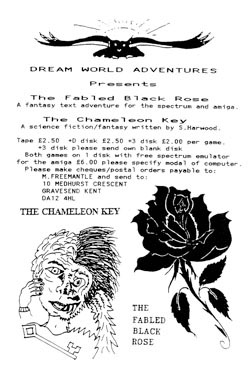 It was a period in time when the community expended lots of effort converting games between the Spectrum, Amstrad and Commodore formats so they could be enjoyed by a wider audience. Philip Reynolds, of the Adventure Workshop, built his company around this and he was responsible for converting almost all your adventures to CP/M on the Amstrad. Did you ever see these ports or play them at the time?
It was a period in time when the community expended lots of effort converting games between the Spectrum, Amstrad and Commodore formats so they could be enjoyed by a wider audience. Philip Reynolds, of the Adventure Workshop, built his company around this and he was responsible for converting almost all your adventures to CP/M on the Amstrad. Did you ever see these ports or play them at the time?
"Philip Reynolds another great chap, yes he ported all or most of my games to Amstrad. I never saw them though."
Your later games included The Fabled Black Rose, Serendipity, and The Caves of Skull. These adventures are a real mix of different styles, themes and settings. The Fabled Black Rose has almost a fairy-tale feel to it whereas Serendipity leans heavily into humour… I particularly liked the animated slot machine in Serendipity.
"Fabled Black Rose… never thought of it as a fairy-tale but I think you are right now you have said it. Just a snippet, Sharon playtested it and was not impressed by it, she statted that the only reason she finished it was because there was NO f*cking Goblins in it!! It was still fantasy, which is what I like in adventures; Sci fi in films; both genres in books.
Serendipity is almost the fun game I`ve always wanted to do. I was and am pleased with it. But I wanted to go further than I did and that's why I did start Serendipity ll which will be done the way I want it to be, let's say it will be past the mark."
Because it came out so late in the day, I hadn't played Caves of Skull myself until I started writing these questions for you. It has been described as "an amazing, challenging game" with several "fiendish puzzles" by Terri over at CASA and, from what I've seen, I think she's got that spot on. In many ways, it's a return in style to your early games with lots of neat little graphical touches… I was particularly shocked by the mirror section as I coded a game based on that idea myself last year, in 2020. Perhaps I wouldn't have bothered if I'd known it'd been done already twenty-five years earlier! It's a fun little trick, although one you sensibly saved until near the end of the game.
"I agree Caves of Skull was a return to my style of good ole fantasy stuff. Sorry Gareth I did it first, the mirror section. This is where I`m always trying to have something new or never been done before, making PAW do something even the developers didn't think of or was even possible.
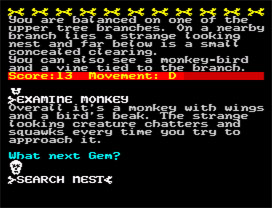 |
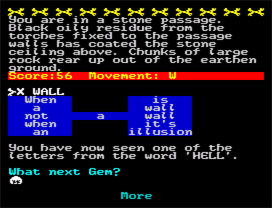 |
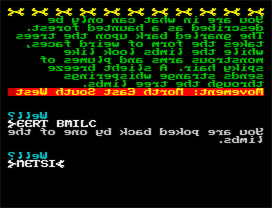 |
But sadly as you say too late in the day to have been seen by the masses which is a pity because if as you and others do say that it's a very good one, then they have missed out. Does that make sense?"
Yes, so many of those early to mid-1990s text adventures didn't get played by anywhere near as many people as they deserved to be seen by. There are plenty of examples that are much better than the early Quilled titles that sold in huge numbers in the 1980s.
"On another miffed-off note: Gilisoft and PAWS. I wrote to them twice back in 92. At the end of the PAWS manual it says if you find any bugs let us know, so I did.
If you use compression while working on a Speccy +2A it just messes your data up, it doesn't work. The b*stards couldn't even be bothered to write back and say we know or thanks for that or tell me to p*ss off. F*cking arseh*les!"
Gilsoft were far from the only software house caught out by the incompatibility issues of the "black" +2. It was a bit of a mess of a machine and the whole reason for all the internal changes, the promised external 3" disk interface from Amstrad, failed to ever materialise.
 The final game we have on record for you at the moment is Tattoo which, like the earlier Curse of the Serpent's Eye, was originally written for the Megapoints competition at the annual UK Adventurer's Convention.
The final game we have on record for you at the moment is Tattoo which, like the earlier Curse of the Serpent's Eye, was originally written for the Megapoints competition at the annual UK Adventurer's Convention.
"Tattoo is just a Megapoints game and nothing more and never will be. I was miffed in the past that it had been reviewed as it should not be as it was never sold or released as a free game. I don't even know how it got into the public domain. Must have been a playtester who passed it on without really thinking about it."
The UK Adventure Conventions were held in Birmingham (later Coventry) every year from 1990 until about 2009, and were a chance for adventure players on all machines to meet up and celebrate the scene. What do you remember about those days?
"The conventions were fantastic times as far as I was concerned. I`ve mentioned the Larry meeting earlier. I also met Jack Lockerby. He was selling his newest adventure The Ellisnore Diamond. I asked him if it was based on the book Moonfleet, he replied yes and how did I know that? Well, I had read it the other night.
Here's a little known fact about me and books. I'm a prolific reader and very fast. I will read between five and eight books simultaneously, and read a standard size book in two to three hours. At 16, I first read Lord of the Rings. It took me six months. Read it again aged 25, in two months. Last time, aged 32, it took ten days.
Jack asked me if I had read other classics, I sure had and proceeded to name a few: Robert Louis Stevenson's books, Dickens, Edgar Rice Burroughs, Jules Verne, Daniel Defoe, Oscar Wilde, Homer, H. G. Wells, Sven Hassel, the list went on and on. That was besides all the sci-fi, fantasy, history, thrillers, political thrillers, geography, comedy and anything that was based on true events. Jack seemed shocked and impressed that someone so young had read so much. I was about 27. So we had a good long chat about books and other stuff as well and I also bought his game.
I attended every convention except the very first one, I don't remember ever having a bad time. The whole thing was fun and enjoyable. I enjoyed meeting everybody, I was the only English person who went out with the Scottish crowd. I had some fantastic times with Danny and Lorna Patterson, Mike and Margret Crewdson, and many others too. To me it was one big party of over indulgence, eating, drinking and merriment. I could tell a few stories about those times, some funny, some maybe embarrassing.
One dear lady, Edwina Brown, used to bring sandwiches to every convention for Larry and I because we were big lads and must be feeling hungry all the time. I don't think poor ole Lazzer understood what was going on. I always thanked her and tucked in, much to her delight."
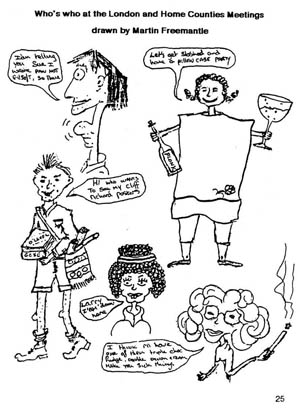 Because of your geographical location, you also got to participate in the more regular, but more informal "south-east" Hamilton Halls adventure gatherings. Again, fun times?
Because of your geographical location, you also got to participate in the more regular, but more informal "south-east" Hamilton Halls adventure gatherings. Again, fun times?
"The Hamilton Halls meetings were much the same for me, just a lot smaller and for only one day with no one or two night stop overs. Some of us drank too much, most of the girls ate too much chocolate pudding. I always tried to make Sharon laugh till she wet herself or spat her drink across the table."
Adventure players may have experienced some aspects of these get-togethers through the Sharon Harwood games Murder at Hamilton Halls and The Spectre of Larry Horsfield, which document the regular attendees involvement in the mysterious (but completely fictitious) death of adventure writer Larry Horsfield. It must be a little strange to be a character in a computer game?
"I never thought anything of it. It was mainly Sharon and me that did it with the Hamilton Halls gang. In one of my games there`s two old crones. That is Sharon and her sister Lynne, Sharon put us all in the "Larry" sagas. I think only my character went a bit further because I wouldn't have been offended. There was a message written in red lipstick on a mirror in the ladies loo that said "I love Martin". Now this started as a little joke created by Lynne and then Sharon about the barman at Hamilton Halls having a crush on me, hilarious.
In Serendipity there`s most of the London gang in it including myself, the naked tattooed man with a dictionary (in relation to my awful spelling)."
By the middle of the 1990s, most 8-bit text adventure gamers were actually playing (and in some cases writing) their Spectrum games using emulators on their 16-bit machines and PCs. This extended the life of the 8-bit adventures, but gradually more and more people left the scene. How and why did you drift away from text adventuring?
"That`s a hard one to answer, maybe just a natural progression, like the way the computers got more powerful. Also text adventures were not my only passion, I love dungeon crawlers like Dungeon Master, games like Dune 2, Might and Magic. I have written loads of dungeons for Dungeon Master Java.
One other thing is work and life itself. In 2000 I took a good look at things and made some major decisions, like I was not going to be working till I was 67, maybe have a few years retirement and then peg it. The plan was to retire at 55 and move somewhere warm and I did. I now live in Spain, have loads of land, my own swimming pool and do whatever I want when I want.
I kind of drifted back into text adventures back in 2007/8. I was pestered by Karen Tyres to try ACE, which was almost a PAW replacement, well about 95%, for the PC written by Andy Clark son of Peter Clark. Personally I think it's the best one out of the writing utilities I have tried."
What was the game?
"I never really gave it a name as it was loosely based on the unfinished PAW game Gate of Doom. I still have all the files.
Anyway I started that game and showed it to Karen, Doreen Barden and a few others at the Coventry convention in 2008, which may have been the last one? I`m not certain. She was very impressed as I`d done my usual trick of incorporating sound and graphic effects and that was just the start screen."
What's made you get back into adventure gaming now? Do you have any unfinished projects or plans for new games?
"The reason I`m back is because I do have free time to pursue all my interests, one being the adventure scene. And yes I have projects on the go right now. One is an adventure I started back in 96, about three-quarters complete, and two new ones, Serendipity 2, and a brand new adventure in a new style I hope. If I do more after that, who knows..."
My thanks go to Martin Freemantle for taking the time to answer questions about his games.
|
